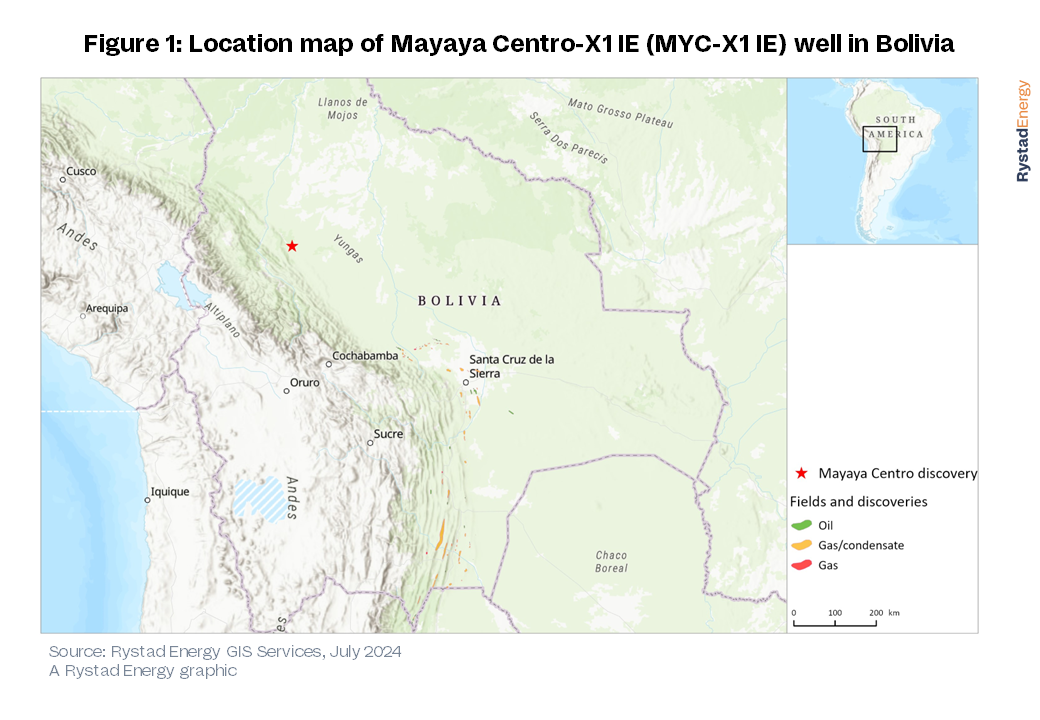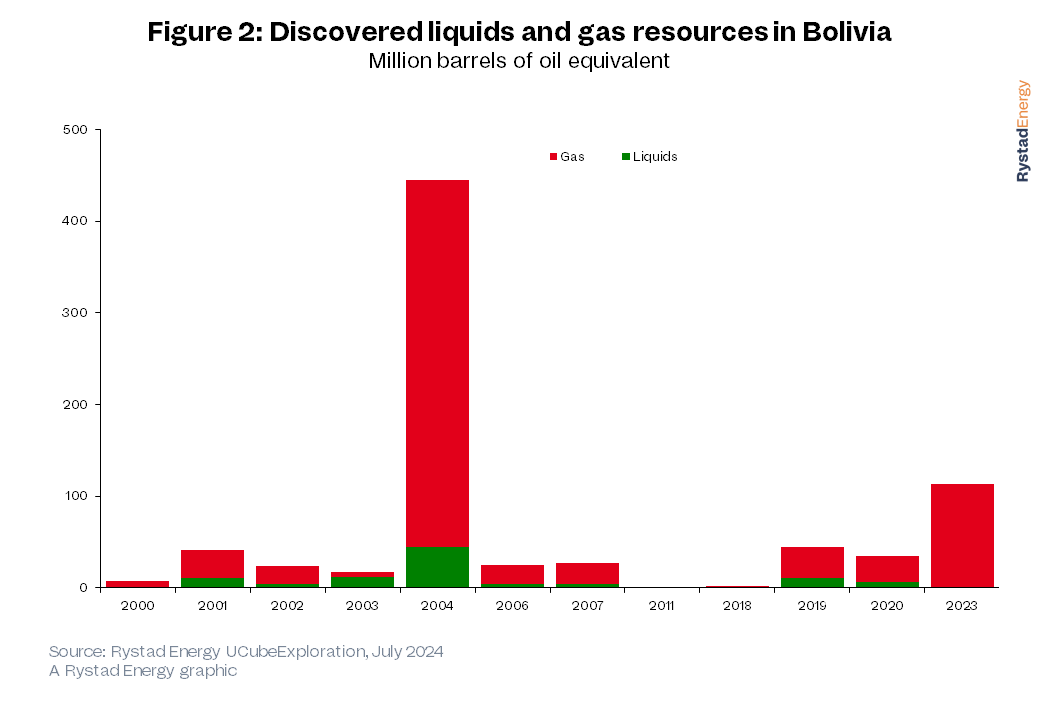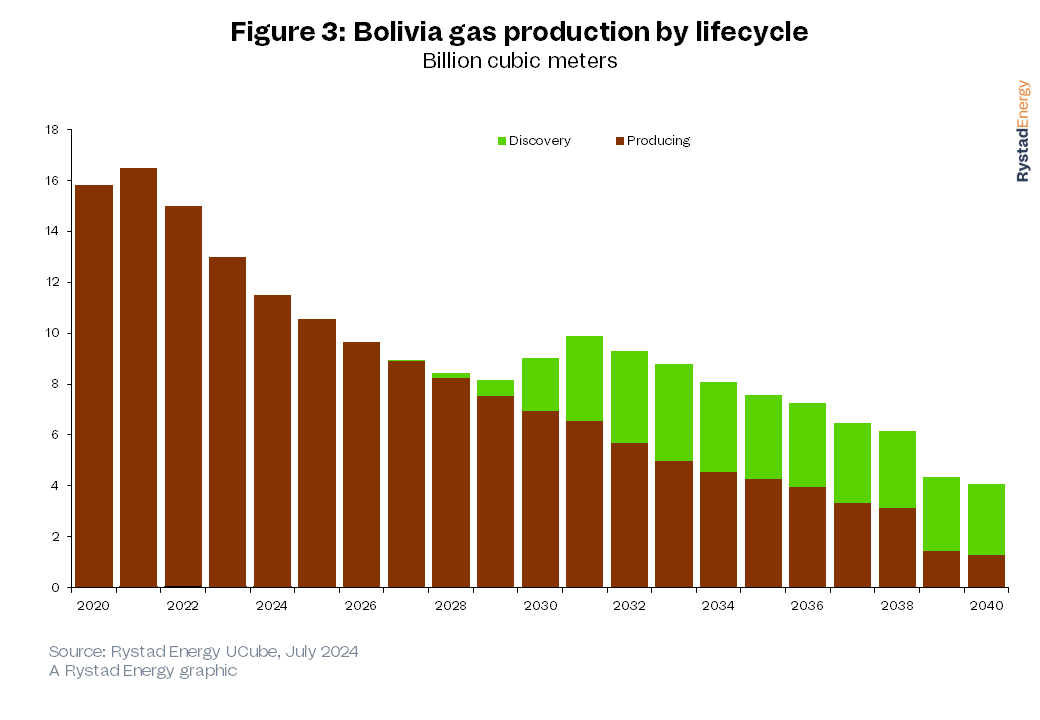Bolivia’s announcement last week of a sizeable gas discovery has stoked optimism that the landlocked South American nation can arrest declining production and boost reserves, although further exploration work is needed to assess reservoir potential, with a prognosed fast-track development in as little as two years appearing optimistic. State player YPFB last week announced successful completion of its stratigraphic research well, Mayaya Centro-X1 IE, which it said hit a significant hydrocarbon volume equivalent to around 1.7 trillion cubic feet (Tcf) of gross unrisked resource. The new discovery, along with YPFB’s 2023 Remanso-X1 find, adds much-needed positive imputes to the upstream sector in the country, which is struggling to sustain production due to the lack of available volumes resulting from subdued exploration and development activity to replace produced volumes. This has led to decreasing exports to neighbors Brazil and Argentina. The back-to-back discoveries will help rejuvenate the country’s exploration outlook, led in particular by YPFB, which launched the Upstream Reactivation Plan (PRU) in July 2021. The plan prioritizes investments in exploring and exploiting the country’s oil and gas reserves, with a focus on the Subandean fold and thrust belt, Bolivia's most significant petroleum region, along with reactivation of more mature fields.

YPFB started drilling at the Mayaya Centro-X1 IE (MYC-X1 IE) well in November 2021 to better understand the sub-surface and drill through various stratigraphic intervals to derisk the technical and operational risk associated in penetrating each formation. The well was drilled to an estimated depth of about 6,000 meters, penetrating a thick sequence of the Charqui and Quendeque formations, deposited at a depth of around 3,000 meters, before entering the gas-prone Middle Carboniferous Retama and gas-condensate-prone Late Devonian Tomachi formations. The well is estimated to have cost around $44 million, with hydrocarbons envisaged deposited within a fault-bounded structure.
Completion of the stratigraphic well culminating in a hydrocarbon discovery resulted from lengthy efforts at data acquisition and investigation, including regional and local seismic interpretation, acquisition, processing and interpretation of magnetotelluria, to help study the electrical resistivity of the sub-surface, combined with detailed understanding of the subsurface geology by combining available well data. However, as Mayaya Centro is a stratigraphic well, exploration is in its initial stage and will require a few more wells to be drilled to better understand the reservoir potential. Nonetheless, the state operator is optimistic about the result and intends to fast-track development within the next two to three years. If the hydrocarbon potential is proven, the well could yield a considerable recovery rate, holding around 150 million barrels of oil equivalent (boe), making it the largest discovery to be announced in Bolivia since TotalEnergies’ Incahuasi, discovered in 2004. This would give a significant boost to reserves in the country, which has only managed to discover around 780 million boe of new reserves since 2000.

Such announcements of new discoveries give hope for Bolivia to arrest declining production – at least temporarily – while replenishing remaining reserves and providing economic gains via exports. Nonetheless, muted exploration activity and the announcement of just one or two such discoveries mean Bolivia is far from achieving these goals and the country will have to ramp up exploration activity, which may prove relatively costly given reservoir depths and associated complexities.
Domestic gas production, which has been in constant decline, currently stands at around 12 billion cubic meters per annum (Bcma), compared to about 20 Bcm in 2013, and is expected to continue declining to around 9 Bcma by the end of the decade, according to Rystad energy estimates. Production is expected to ramp up slightly thereafter, although the available undeveloped fields are not large enough to sustain this output for long (Figure 3).
Development of Mayaya Centro-X1 IE would help inject new volumes, with YPFB’s announcement saying the field could produce up to 10 million cubic meters per day of gas and between 500 and 1,000 barrels per day of liquids via a three-well development campaign. Nonetheless, development activity within the stipulated timeframe of two to three years is an ambitious target, given the location of the discovery – Mayaya Centro-X1 IE lies in an undeveloped area away from existing fields and would call for the establishment of new infrastructure to export produced volumes.

The relative lack of substantial new resources for development is depleting Bolivia’s proven reserves and, as such, the country’s reserve replace ratio. According to official records from Bolivia, the country’s proven gas reserves as of December 2018 were around 8.95 Tcf and it has since produced around 2.7 Tcf of gas between 2019 and 2023, while only managing to add about 1.1 Tcf of new gas volumes via exploration. The nation has a dual responsibility of replenishing reserves at its mature fields via various enhanced oil recovery (EOR) activities and spearheading exploration to explore its remaining subsurface potential.
Bolivia has long been an exporter of natural gas to Brazil and Argentina, but it has struggled to sustain volumes on the back of a steady decline in production over the past decade, barring a small gain in 2021 because of a recovery from the Covid-19 pandemic. Therefore, new exploration successes could lead to an increase in exploration activity and inject fresh hope in replenishing the country’s gas reserves.
ADVERTISEMENT
More Top Reads From Oilprice.com:
- Oil Prices Climb Following Saturday's Rocket Attack on the Golan Heights
- Ukraine Targets Russian Energy Infrastructure in Retaliatory Drone Strikes
- UK's Energy Market to Embrace Flexibility for a Cleaner Future


















